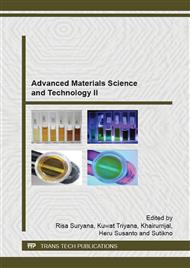[1]
Y.A. Dzenis, Spinning continuous fibers for nanotechnology, Science 304 (2004) 1917–(1919).
DOI: 10.1126/science.1099074
Google Scholar
[2]
J. Weigang, X. Zhang, S. Wu, Wet chemical synthesis of ag nanowires array at room temperature, Chemistry Letters 34 (4) (2005) 510-511.
DOI: 10.1246/cl.2005.510
Google Scholar
[3]
K.E. Hnida, P.S. Robert, D.S. Grzegorz, Polypyrrole–silver composite nanowire arrays by cathodic co-deposition and their electrochemical properties, Journal of Physics and Chemistry C 117 (38) (2013)19382–19392.
DOI: 10.1021/jp4038304
Google Scholar
[4]
I. Moreno, N. Navascues, S. Irusta, J. Santamaria, Silver nanowires/polycarbonate composites for conductive films, Material Science and Engineering 40 (2012) 0122001.
DOI: 10.1088/1757-899x/40/1/012001
Google Scholar
[5]
L. Liu, H. Chaodong, L. Jia, G. Jinbao, Y. Dian, W. Jie, Green synthesis of silver nanowires via ultraviolet irradiation catalyzed by phosphomolybdic acid and their antibacterial properties, New Journal of Chemistry 37 (2013) 2179-2185.
DOI: 10.1039/c3nj00135k
Google Scholar
[6]
S. Cui, L. Yunchun, Y. Zhousheng, W. Xianwen, Construction of silver nanowires on dna template by an electrochemical technique, Materials & Design 28 (2) (2007) 722–725.
DOI: 10.1016/j.matdes.2005.08.007
Google Scholar
[7]
A. Amirjani, M. Pirooz, H.F. Davoud, Effect of AgNO3 addition rate on aspect ratio of CuCl2–mediated synthesized silver nanowires using response surface methodology, Colloids and Surfaces A: Physicochemical and Engineering Aspects, 444 (2014).
DOI: 10.1016/j.colsurfa.2013.12.033
Google Scholar
[8]
M. Haibo, F. Jinyang, M. Xiao, W. Can, Z. Xiujian, One-dimensional silver nanowires synthesized by self-seeding polyol process, Journal of Nanoparticle Research 14 (2012) 887-901.
Google Scholar
[9]
Y. Sun, B. Mayers, T. Herricks, Y. Xia, Polyol synthesis of uniform silver nanowires: a plausible growth mechanism and the supporting evidence, Nano Letters 3 (7) (2003) 955–960.
DOI: 10.1021/nl034312m
Google Scholar
[10]
N. Rajeswari, S. Selvasekarapandian, S. Karthikeyan, C. Sanjeeviraja, Y. Iwai, J. Kawamura, Structural, vibrational, thermal, and electrical properties of PVA/PVP biodegradable polymer blend electrolyte with CH3COONH4, Ionics 19 (2013) 1105–1113.
DOI: 10.1007/s11581-012-0838-1
Google Scholar
[11]
C. Chen, W. Li, Y. Haojie, J. Guohua, Y. Qiang, Z. Junfeng, X. Weidong, Z. Jinfeng, Study on the growth mechanism of silver nanorod in the nanowire-seeding polyol process, Material Chemistry and Physics 107 (2008) 13-17.
Google Scholar
[12]
B. Wiley, S. Yugang, X. Younan, Synthesis of silver nanostructures with controlled shapes and properties, Accounts of Chemical Research 40 (2007) 1067–1076.
DOI: 10.1021/ar7000974
Google Scholar
[13]
S. Coskun, B. Aksoy, H.E. Unalan, Polyol synthesis of silver nanowires: An extensive parametric study, Crystal Growth Design 11 (2011) 4963–4969.
DOI: 10.1021/cg200874g
Google Scholar
[14]
Y. Sun, B. Gates, B. Mayers, Y. Xia, Crystalline silver nanowires by soft solution processing, Nano Letters 2 (2) (2002) 165-168.
DOI: 10.1021/nl010093y
Google Scholar
[15]
M.R. Johan, N.A.K. Aznan, S.T. Yee, I.H. Ho, S.W. Ooi, N.D. Singho, F. Aplop, Synthesis and growth mechanism of silver nanowires through different mediated agents (CuCl2 and NaCl) polyol process, Journal of Nanomaterials 2014 (2014) 1-7.
DOI: 10.1155/2014/105454
Google Scholar
[16]
H. Mao, J. Feng, X. Ma, C. Wu, X. Zhao, One-dimensional silver nanowires synthesized by self-seeding polyol process, Journal of Nanoparticle Research 14 (2012) 887-901.
DOI: 10.1007/s11051-012-0887-4
Google Scholar
[17]
J.Y. Lin, Y.L. Hsueh, J.J. Huang, The concentration effect of capping agent for synthesis of silver nanowire by using the polyol method, Journal of Solid State Chemistry 214 (2014) 2-6.
DOI: 10.1016/j.jssc.2013.12.017
Google Scholar


